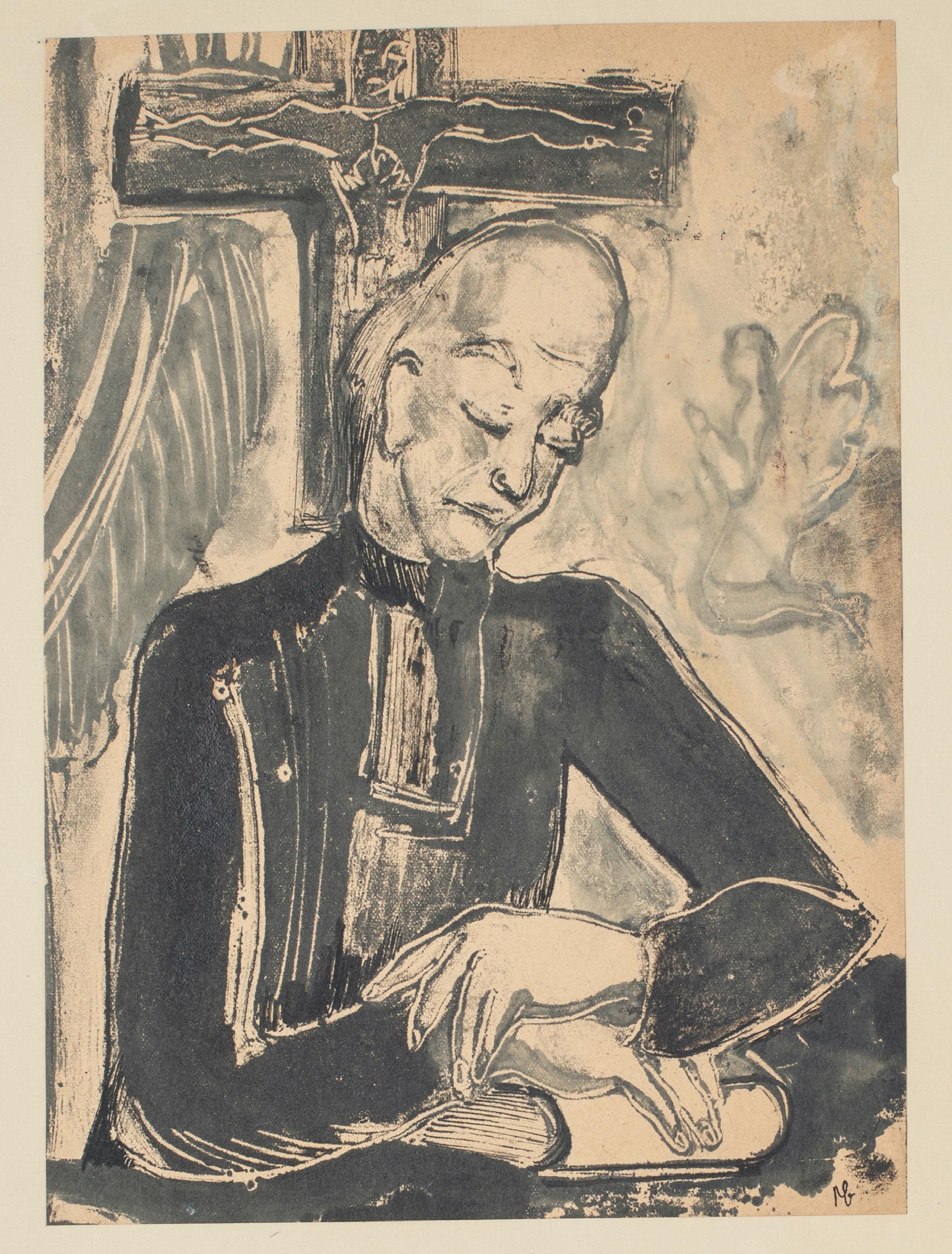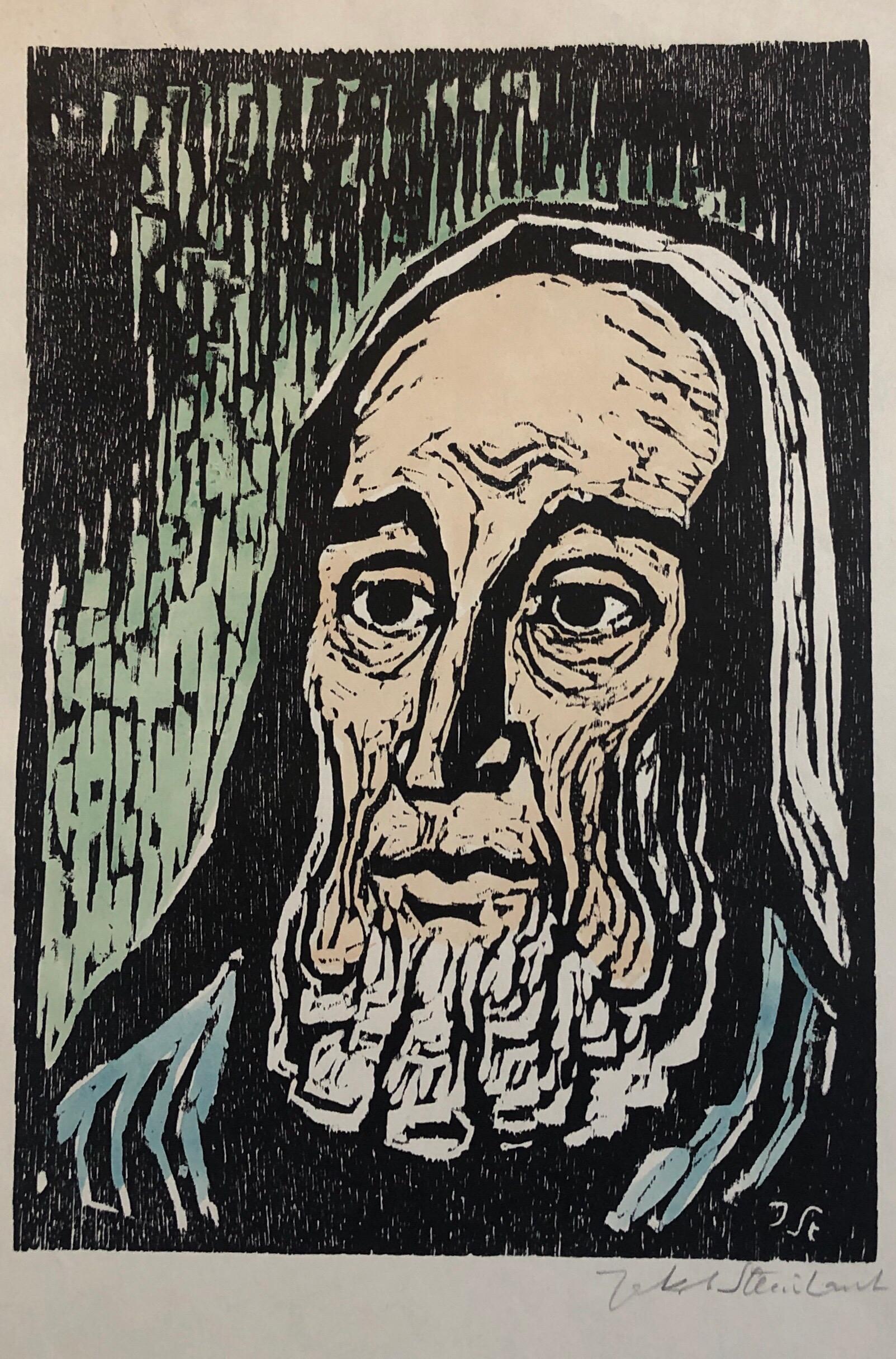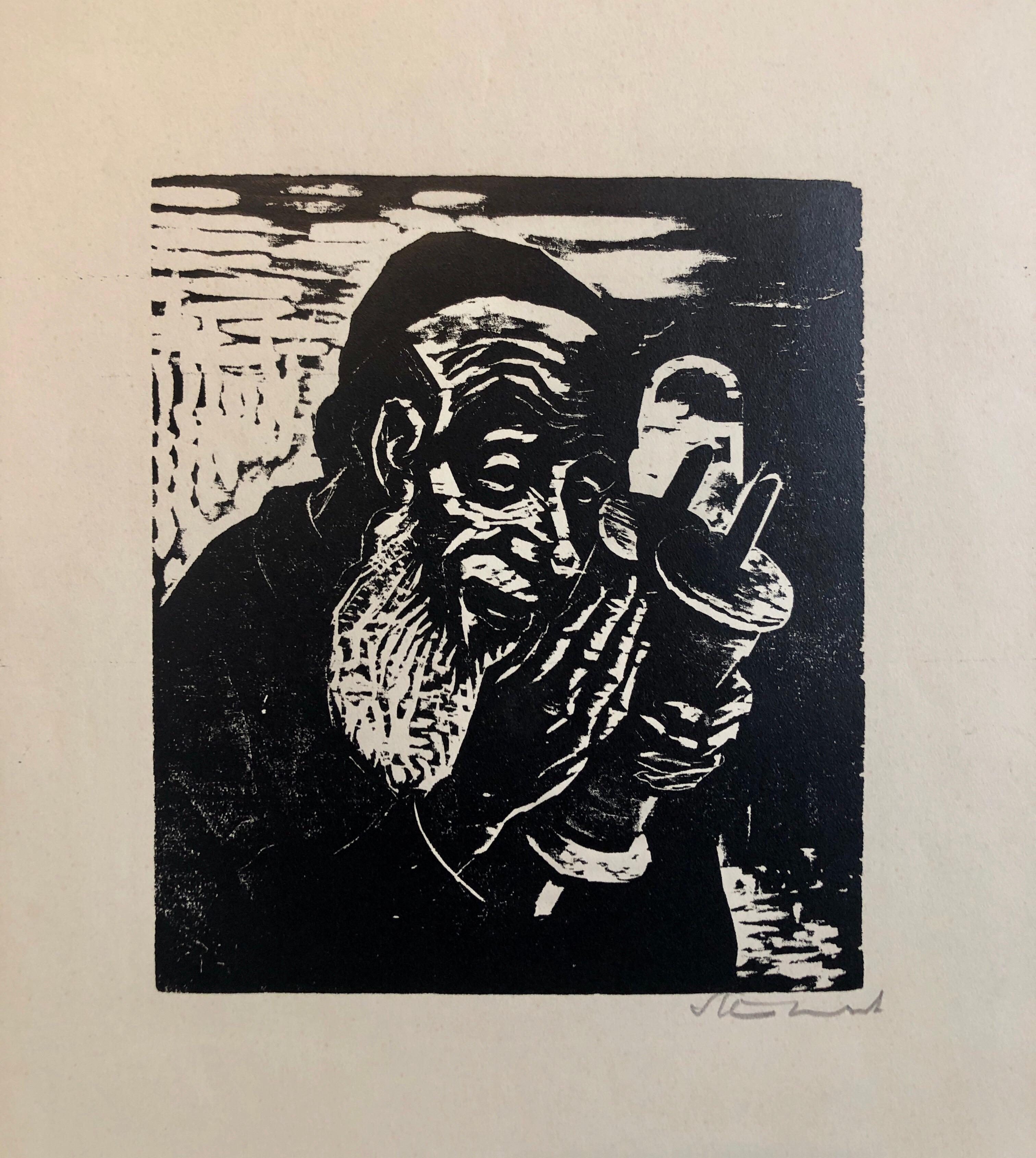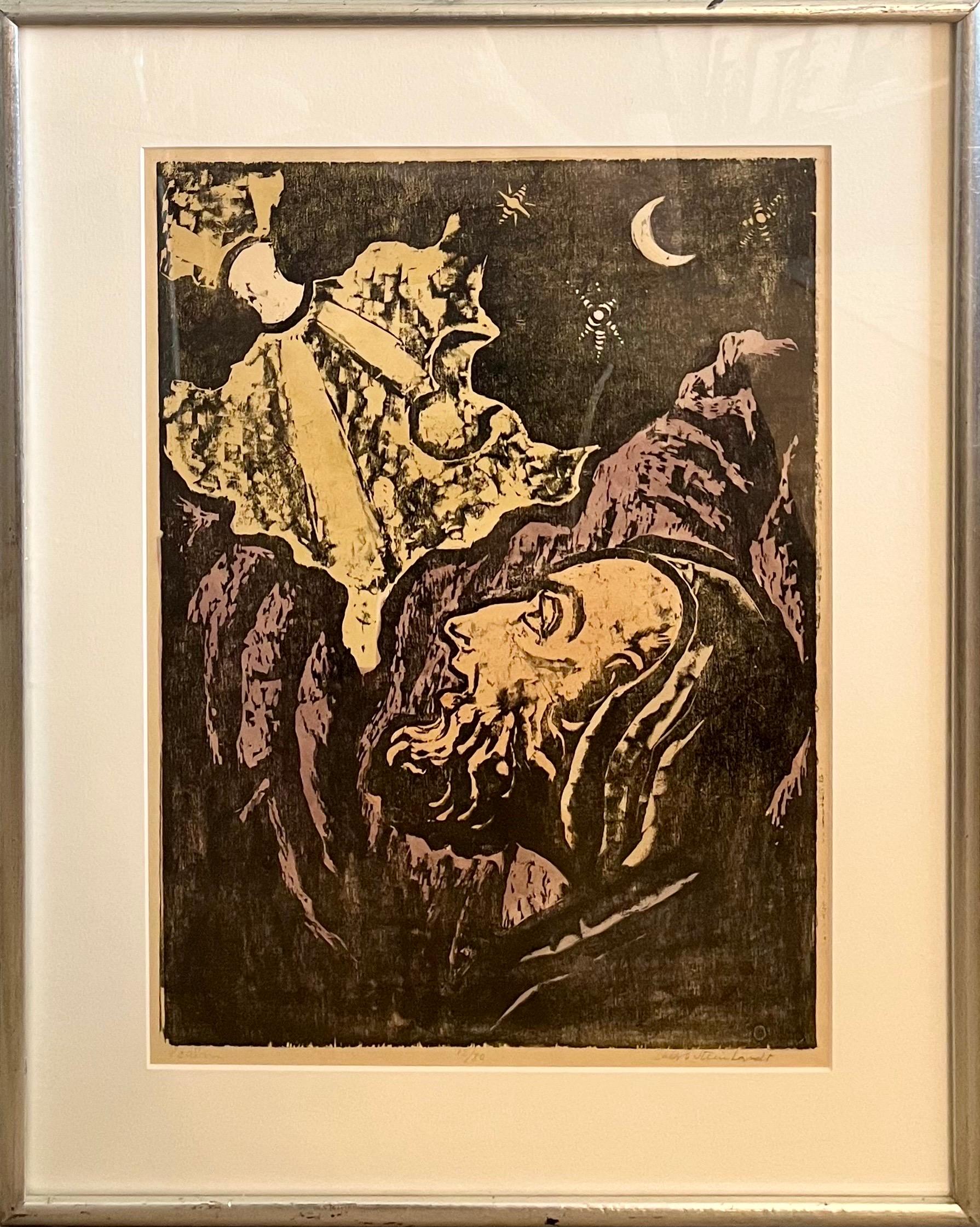Items Similar to Jakob Steinhardt Jewish German Expressionist Lithograph Israeli Early Bezalel
Want more images or videos?
Request additional images or videos from the seller
1 of 6
Jacob SteinhardtJakob Steinhardt Jewish German Expressionist Lithograph Israeli Early Bezalel
About the Item
plate signed.
Jacob Steinhardt
1887-1968
Steinhardt, Jakob, Painter and Woodcut Artist. b. 1887, Yaacov Steinhardt was born in the then remote, largely Polish town of Zerkow in the Posen District of Germany. (poland/german) Immigrated 1933. Studies: 1906 School of Art, 1906 Studied in Berlin Arts and Crafts School. Berlin; 1907 painting with Lovis Corinth and engraving and etching with Hermann Struck; advanced studies, 1908-10 Paris, with Henri Matisse and Steinlen; 1911 Italy. Teaching: Bezalel, Jerusalem, 1953-57 Director. 1910 Participated in the “New Sezession”, Berlin. 1912 together with Ludwig Meidner and Janthur he founded the "Pathetiker" group very early in the German expressionist movement. Running afoul of the Nazis, he fled to Tel-Aviv and then Jerusalem in the early 30s, showing in “Der Sturm” Gallery. 1914 Exhibited with ludwig Meidner at first Expressionist Exhibition in Berlin. Worked mainly in woodcuts depicting biblical and other Jewish subjects. 1955-58 International awards for his woodcuts. receives graphic commissions from Fritz Gurlitt. 1922 Marries Minni Gumpert. Active in organizing Secession exhibits. 1925 Trips to Mark Brandenburg and Holy Land. Turns primarily to painting; stops work on etchings and lithographs. 1933 Emigrates to the Palestine. 1934 Moves to Jerusalem and opens an art school; attempts some etchings. 1948 Closes the art school and becomes Chairman of Graphics Department, Bezalel School for Arts and Crafts. 1954-57 Director of Bezalel School for Arts and Crafts. Taken up by J. B. Neumann who became the agent for his etchings. Exhibited Sturm Gallery, Herbst-salon. 1914 Outbreak of World War I; Steinhardt enlists in German army. 1916-18 First on Eastern Front in Poland and Lithuania, then after short training period in Berlin, sent to Macedonia. 1917 Exhibition of Lithuanian drawings at Berlin Secession in Spring. Elected member of the Secession.
He often used wood-cutting techniques that were popular amongst German Expressionists. Steinhardt was driven to express ideas clearly and decisively through art.
Amongst the themes found in his work the prophets of the Bible, such as Jonah, are noticeable. Steinhardt identified deeply with Jonah due to his attempt to run from God's call to duty.
Additionally, the image of beggars was often found in Steinhardt's works and in his artistic presentation of the less fortunate, the artist's love for his fellow man becomes evident.
Moreover, the grotesque was a theme noticeable in Steinhardt's earliest pieces. These were fantastical images; it was unclear whether or not they were human or demon. In the 1950's, Steinhardt returned to these images upon learning of the Holocaust of Europe's Jews. At that time he resided in New York and there, in the shadow of the skyscrapers, Steinhardt's reaction to WWII was expressed through his art.
A Collection of Works by Artists of the Land of IsraelThe Bezalel National Museum, Jerusalem 1940 Artists: Shemi, Menahem Rubin, Reuven Avni, Aharon Mokady, Moshe Jonas, Ludwig Steinhardt, Jakob Ticho, Anna Krakauer, Leopold Gutman, Nachum Budko, Joseph Ardon, Mordecai Sima, Miron Castel, Moshe Pann, Abel Struck, Hermann Gur Arie, Meir Ben Zvi, Zeev Litvinovsky, Pinchas
Education
1906 Berlin Art Museum, Berlin
1907 painting with Louis Corinth and engraving with Hermann Struck, Berlin
1909-1910 Académie Julian, Paris
1909-1910 Académie Colarossi, Paris
1909-1910 Académie Matisse, Paris
Teaching
1934-1949 Instructor drawing, painting and printing, The Studio
1949-1957 Instructor, New Bezalel, Jerusalem
1949-1953 Head of graphics department, New Bezalel, Jerusalem
1953-1957 Director, Bezalel Academy of Arts and Design, Jerusalem
Awards And Prizes
1939 IBM prize, New York World's Fair, New York, USA
1955 First Prize, Sao Paolo Biennale, Brazil
1958 California Print Makers Prize, San Francisco, USA
1959 Arte Liturgica Prize, Venice Biennale, Italy
1961 Arte Sacra Prize, The International Biennial for Religious Art, Trieste, Italy
- Creator:Jacob Steinhardt (1887 - 1968, Israeli)
- Dimensions:Height: 11.5 in (29.21 cm)Width: 9 in (22.86 cm)
- Medium:
- Movement & Style:
- Period:
- Condition:good. light creasing.
- Gallery Location:Surfside, FL
- Reference Number:1stDibs: LU38214056642
About the Seller
4.9
Platinum Seller
These expertly vetted sellers are 1stDibs' most experienced sellers and are rated highest by our customers.
Established in 1995
1stDibs seller since 2014
1,565 sales on 1stDibs
Typical response time: 1 hour
- ShippingRetrieving quote...Ships From: Surfside, FL
- Return PolicyA return for this item may be initiated within 3 days of delivery.
More From This SellerView All
- Jewish Prophet Rabbi German Expressionist Color Woodcut Israeli Early BezalelBy Jacob SteinhardtLocated in Surfside, FLHand signed in pencil, colored woodcut. Jacob Steinhardt 1887-1968 Steinhardt, Jakob, Painter and Woodcut Artist. b. 1887, Yaacov Steinhardt was born in the then remote, largely...Category
20th Century Expressionist Figurative Prints
MaterialsWoodcut
- Jewish Rabbi with Torah German Expressionist Woodcut Israeli Early BezalelBy Jacob SteinhardtLocated in Surfside, FLHand signed in pencil, woodblock print woodcut. Jacob Steinhardt 1887-1968 Steinhardt, Jakob, Painter and Woodcut Artist. b. 1887, Yaacov Steinhardt was born in the then remote,...Category
20th Century Expressionist Figurative Prints
MaterialsWoodcut
- Steinhardt Woodcut Marian Anderson Signed African American, Israeli Bezalel ArtBy Jacob SteinhardtLocated in Surfside, FLPortrait in black and white, woodblock print. Pencil signed by both Jacob Steinhardt 1887-1968 and Marian Anderson. Very rare thus. (Commissioned by Dr. Leon Kolb, San Francisco) 3...Category
1950s Expressionist Figurative Prints
MaterialsWoodcut
- Jewish Rabbi Looking Heavenward German Expressionist Woodcut Israeli "Psalm"By Jacob SteinhardtLocated in Surfside, FLJacob Steinhardt, 1887-1968 Hand signed in pencil, woodblock print woodcut. Frame: 22.5" x 18" Image: 16.75" X 12.5" "Psalm" 12/30 Jakob Steinhardt, Painter and Woodcut Artist. b. 1887, Yaacov Steinhardt was born in the then remote, largely Polish town of Zerkow in the Posen District of Germany. (poland/german) Immigrated 1933. Studies: 1906 School of Art, 1906 Studied in Berlin Arts and Crafts School. Berlin; 1907 painting with Lovis Corinth and engraving and etching with Hermann Struck; advanced studies, 1908-10 Paris, with Henri Matisse and Steinlen; 1911 Italy. Teaching: Bezalel, Jerusalem, 1953-57 Director. 1910 Participated in the “New Sezession”, Berlin. 1912 together with Ludwig Meidner and Janthur he founded the "Pathetiker" group very early in the German expressionist movement. Running afoul of the Nazis, he fled to Tel-Aviv and then Jerusalem in the early 30s, showing in “Der Sturm” Gallery. 1914 Exhibited with ludwig Meidner at first Expressionist Exhibition in Berlin. Worked mainly in woodcuts depicting biblical and other Jewish subjects. 1955-58 International awards for his woodcuts. receives graphic commissions from Fritz Gurlitt. 1922 Marries Minni Gumpert. Active in organizing Secession exhibits. 1925 Trips to Mark Brandenburg and Holy Land. Turns primarily to painting; stops work on etchings and lithographs. 1933 Emigrates to the Palestine. 1934 Moves to Jerusalem and opens an art school; attempts some etchings. 1948 Closes the art school and becomes Chairman of Graphics Department, Bezalel School for Arts and Crafts. 1954-57 Director of Bezalel School for Arts and Crafts. Taken up by J. B. Neumann who became the agent for his etchings. Exhibited Sturm Gallery, Herbst-salon. 1914 Outbreak of World War I; Steinhardt enlists in German army. 1916-18 First on Eastern Front in Poland and Lithuania, then after short training period in Berlin, sent to Macedonia. 1917 Exhibition of Lithuanian drawings at Berlin Secession in Spring. Elected member of the Secession. He often used wood-cutting techniques that were popular amongst German Expressionists. Steinhardt was driven to express ideas clearly and decisively through art. Amongst the themes found in his work the prophets of the Bible, such as Jonah, are noticeable. Steinhardt identified deeply with Jonah due to his attempt to run from God's call to duty. Additionally, the image of beggars was often found in Steinhardt's works and in his artistic presentation of the less fortunate, the artist's love for his fellow man becomes evident. Moreover, the grotesque was a theme noticeable in Steinhardt's earliest pieces. These were fantastical images; it was unclear whether or not they were human or demon. In the 1950's, Steinhardt returned to these images upon learning of the Holocaust of Europe's Jews. At that time he resided in New York and there, in the shadow of the skyscrapers, Steinhardt's reaction to WWII was expressed through his art. A Collection of Works by Artists of the Land of IsraelThe Bezalel National Museum, Jerusalem 1940 Artists: Shemi, Menahem Rubin...Category
20th Century Expressionist Figurative Prints
MaterialsWoodcut
- Lithograph Israeli Modernist Judaica, Kibbutz Boy, Bezalel ArtistBy Moshe GatLocated in Surfside, FLA signed and numbered lithograph print. Moshe Gat was born in Haifa in 1935. in 1952 he began his studies at the Bezalel School, in Jerusalem. In 1955 he returned to Haifa, where h...Category
Mid-20th Century Expressionist Figurative Prints
MaterialsLithograph
- Dutch Fantastic Modern Etching, Jan Mensinga Old Master Style Wine Maker, GrapesLocated in Surfside, FLJan Roelf Mensinga, Dutch artist, painter, graphic printmaker, watercolor artist. (born Leeuwarden 1924 - 1998 Amsterdam) Education: Mensinga attended an art studies from 1954 to 1...Category
20th Century Expressionist Figurative Prints
MaterialsEtching
You May Also Like
- Men - Pair of Original Monotype Woodcuts - Mid 1900Located in Roma, ITMen is a pair of two original monotype woodcuts realized by an Anonymous artist of the XX century, in 1950 ca, glued on paper. In very good condition. Image dimension : 26 x 19.5 c...Category
Mid-20th Century Expressionist Portrait Prints
MaterialsWoodcut
- Félix Vallotton ( Swiss 1865 - 1925) L’Exécution Woodcut 18/25 , SwitzerlandBy Félix VallottonLocated in Meinisberg, CHFélix Vallotton (Swiss, 1865 - 1925) L’Exécution • Wood cut print • Loose Japan paper sheet, 25 x 37 cm • Block, ca. 15 x 25 cm • Monogrammed in the ...Category
1890s Expressionist Figurative Prints
MaterialsPaper, Ink, Woodcut
- Transcend, Kate Willows, Limited Edition Print, Angelic Artwork, Affordable ArtLocated in Deddington, GBTranscend by Kate Willows [2017] limited edition Ink on paper Edition of 40 Image size: H:30 cm x W:20 cm Sold Unframed Please note that insitu image...Category
21st Century and Contemporary Expressionist Portrait Prints
MaterialsPaper, Ink
- Original Vintage Secession Poster celebrating the emperor's jubileeLocated in Zurich, CHOriginal Vintage Poster by the Austrian artist Ferdinand Ludwig Graf, a member of the Hagenbund. This Viennese artist association moved as soon a...Category
Early 1900s Vienna Secession Figurative Prints
MaterialsPaper
- Marc Chagall - Four Tales from the Arabian Nights - COMPLETE SET (12)By Marc ChagallLocated in Los Angeles, CAMarc Chagall (1887-1985) FOUR TALES FROM THE ARABIAN NIGHTS (MOURLOT 36 - 47; CRAMER BOOKS 18) The complete set of twelve lithographs printed in co...Category
Mid-19th Century Expressionist Figurative Prints
MaterialsLithograph, Laid Paper
- Repos, 1999, original lithograph by Jean Jansem handsigned numberedBy Jean JansemLocated in Carouge GE, GEJean Jansem (1920-2013) Repos, Album Danse, 1999 Lithographie sur papier Arches Signée et justifiée 50 x 65 cm / 54 x 76 cm Imprimeur: Mourlot, Paris Editeur: Jansem, Paris Bibliographie: Jansem Lithographe, 1993-1999, Flora Jansem, Paris, n. 155, reproduit p.81, référencé p. 97. "Ma première lithographie date de 1954. Elle représente un enfant en haillons portant deux seaux d'eau, d'après un croquis rapporté de Cordoue lors de mon voyage en Espagne en 1952. Je l'exécutai sur pierre, au pinceau et à l'encre lithographique. Je fus déçu du résultat et n'en tirai qu'un essai et une épreuve. Quatre ans plus tard, je réalisai une dizaine de nouvelles lithographies, toujours sur pierre, la plupart en noir. Au lieu d'employer l'encre et le crayon lithographiques, j'utilisai l'encre zincographique plus fluide me permettant de travailler à la plume ou avec de fins pinceaux de martre. Le tirage fut très satisfaisant. au grand étonnement du Père Guillard, lithographe. Jusqu'alors l'encre zincographique ne servait qu'à la zincographie. Actuellement elle est d'un usage courant puisque pratiquement toutes les lithographies se font sur zinc et non plus sur pierre, ce qui facilite la manipulation. Par ailleurs, le zinc offre autant de possibilités que la pierre. En 1959, La Guilde de la Gravure me demanda une édition en couleur. Je choisis une nature morte aux chardons, tirée à 220 exemplaires. Par la suite, les tirages varièrent de 10 à 160 épreuves. Mes lithographies en couleur étaient assez proches de mes toiles. A partir de 1968, période de La Danse, je supprimai petit à petit le clair-obscur et la matière pour donner plus de légèreté et de transparence. Les lithographies postérieures à 1970 sont dessinées en noir sur un fond coloré souvent volontairement arbitraire, donnant l'aspect d'un dessin rehaussé. La couleur n'est pas intégrée au dessin mais joue un rôle d'accompagnement du trait qui est lui-même une arabesque écrite. Quand le noir...Category
Late 20th Century Expressionist Figurative Prints
MaterialsLithograph





